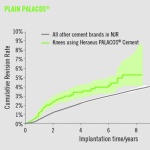
News • Mutation Study
Influential gene neighbourhood
Genes do not exist in isolation. So far, little has been known about how the position of a gene on a chromosome affects its evolution.

Genes do not exist in isolation. So far, little has been known about how the position of a gene on a chromosome affects its evolution.

The association of biofilms with multi-drug resistance has highlighted the need for further understanding of biofilms and for anti-biofilm strategies.

Hospital-acquired infections are both a cause of and contribute to resistance, but a new technology can help.

Ares Genetics GmbH, a wholly-owned subsidiary of Curetis GmbH and a developer of pioneering solutions for the detection of genetic resistances in pathogens, announced that the project "GEAR - Predicting Antibiotic Resistances with Genetic Data" has been awarded in the competition "Landmarks in the Land of Ideas".

A study examining the impact of antibiotics prescribed for nearly 1500 adult patients admitted to The Johns Hopkins Hospital found that adverse side effects occurred in a fifth of them, and that nearly a fifth of those side effects occurred in patients who didn’t need antibiotics in the first place.

Scientists in the UK have developed a new model that will help to advance the study of resistance to antibiotics.

Trips around the globe, healthcare tourism, migration; we are mobile – and so are bacteria. Particularly dreaded are multi-drug resistant bacteria that ‘hop’ on their host during a hospital stay and are carried across the border. At MEDICA 2017 Labmed Forum Dr Andreas Ambrosch, Head of the Central Lab at Krankenhaus Barmherzige Brüder in Regensburg, Germany, will discuss these unwelcome…

Today’s dilemma for hospitals and institutions are increasingly multi-resistant bacteria and decreasingly effective antibiotics to beat them. New substances to fight pathogens are not on the horizon. What can be done? Professor Constanze Wendt, microbiology and infection biology specialist at MVZ Labor Dr. Limbach & Kollegen GbR, in Heidelberg, Germany, describes current anti-infection…

While new agents to fight virulent pathogens are in the pipeline, a new study pinpoints where a recent addition is already being applied in the clinic.

In a vulnerable system the most vulnerable users suffer most – and in the German hospital surgical care system the most vulnerable are children – and, above all, immigrant children.

Survival of mass extinctions helps to explain near indestructible properties of hospital superbugs.

Curetis, a developer of next-level molecular diagnostic solutions, today announced that the Company has established Ares Genetics GmbH, a wholly owned subsidiary of Curetis GmbH. Ares Genetics builds on GEAR GEnetic Antibiotic Resistance and Susceptibility Database and associated assets recently acquired for Siemens. The Company will use GEAR to investigate the genetic foundations of antibiotic…

Researchers from the University of Birmingham and Newcastle University found that the unusual approach of removing antibodies from the blood stream reduced the effects of chronic infections, the requirement for days spent in hospital and the use of antibiotics.
Multidrug-resistant tuberculosis (MDR-TB) is widespread globally, with an estimated 480,000 cases in 2014.Although rare in European countries, the risks posed by the current migrant crisis makes MDR-TB an important and urgent public health priority.

The increasing numbers of bacteria resistant to the newer generations of antibiotics is a public health problem on a global scale. Bacteria have an extraordinary capacity for adaptation, mutating permanently to overcome the action of our increasingly impotent antimicrobial armamentarium. A situation further aggravated by the use of the powerful ‘large spectrum’ antibiotics, creating further…

A global spotlight has at last highlighted the truly acute problem of antimicrobial resistance.

Multidrug resistance (MDR) is the mechanism by which many cancers develop resistance to chemotherapy drugs, resulting in minimal cell death and the expansion of drug-resistant tumors. To address the problem of resistance, researchers at the National Institute of Biomedical Imaging and Bioengineering (NIBIB) at the National Institutes of Health (NIH) have developed nanoparticles that…
The European Society of Clinical Microbiology and Infectious Diseases (ESCMID) and the American Society for Microbiology (ASM) are jointly organizing a conference in Vienna from 21 – 23 September 2016 to help researchers accelerate the development of new antimicrobials for drug-resistant infections.

The mechanism by which drug-resistant bacteria maintain a defensive barrier has been identified by researchers at England’s University of East Anglia (UEA) and their findings could result in a new wave of drugs that can bring down those defensive walls rather than attack the bacteria – thus they may not develop drug-resistance at all.

As one of medicine’s largest challenges, viral infections often escape vaccines due to their natural ability to mutate rapidly and develop drug resistance easily. Many viruses, such as Zika, Ebola and dengue fever, have grown into major global health epidemics with great human and economic toll. IBM Research and Singapore’s Institute of Bioengineering, Nanotechnology (IBN) announced they have…

Small cell lung cancer is not usually detected until it is at an advanced stage, when metastases have already formed. Chemotherapy is very effective initially but, within a year, cancer recurs and this time does not respond to a course of chemotherapy. The research group headed by Gerhard Hamilton, University Department of Surgery at MedUni Vienna, has now managed to identify the reason for this…

A novel class of compounds developed by a University of Saskatchewan (U of S)-led research team could yield more effective and less toxic chemotherapy drugs to treat cancer. Team leader Jonathan Dimmock, a medicinal chemistry researcher in the U of S College of Pharmacy and Nutrition, explained their compounds work by interacting with thiols, naturally occurring chemicals that perform several…

A research team led by University of Arkansas chemist Jingyi Chen and University of Arkansas for Medical Sciences microbiologist Mark Smeltzer has developed an alternative therapeutic approach to fighting antibiotic-resistant infections.

The European Society of Clinical Microbiology and Infectious Disease (ESCMID) – an organization that explores risks, knowledge sharing and best practices in the fight against infectious disease – has received more than 300 late-breaker abstract submissions for its annual congress, ECCMID 2016 in Amsterdam.

There’s apparently safety in numbers, even for cancer cells. New research in mice suggests that cancer cells rarely form metastatic tumors on their own, preferring to travel in groups since collaboration seems to increase their collective chances of survival, according to researchers at Johns Hopkins.